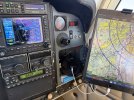Mooney pilots said you had to get the plane on a Step. One way they said was climb above your cruise altitude the let her descend gaining speed to get on the step.
Old wives' tale, though you can make some observations that would seem to support the theory.
Here's why: At cruise (and any time your airspeed isn't changing) there is an equilibrium between thrust and drag. If there's more thrust than drag, you accelerate, if there's more drag than thrust you decelerate.
When you first level off at cruise, there's three ways to get to that equilibrium:
1) Set cruise power immediately and wait. In theory, it would take an infinite amount of time to get to cruise speed, though in terms of any speed change being noticeable it'll only take a few minutes.
2) Get "on the step" (which is a seaplane thing) by climbing an extra hundred feet or so and zooming back down to accelerate to cruise speed more quickly.
3) Leave climb power in, accelerate to cruise speed, and THEN set cruise power.
IME, 2 and 3 take about the same amount of time to get to the condition where you're level at cruise speed with power set, and 3 is really the right way to do things. But if you only try 1 and 2, then 2 looks like a far better option.
C182 RG's said to be slower if loaded aft because of the open rear wheel wells would catch the airflow. Any truth who knows.
Plausible. I believe there are some planes (Swift?) where Vx changes with gear up vs down for this reason too, high AoA = high drag with gear down due to a lot of airflow hitting in the wheel wells.
Think of the airlines. They regularly fly with aft CG to save fuel.
I thought that the large airliners got positive lift from both wing and tail. There's certainly a spot where you achieve the optimum L/D, but is it still at the aft end of the envelope?

